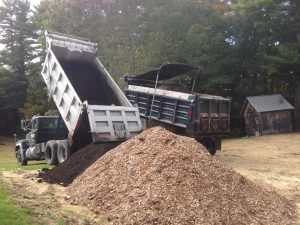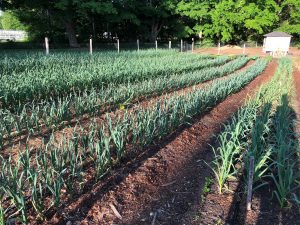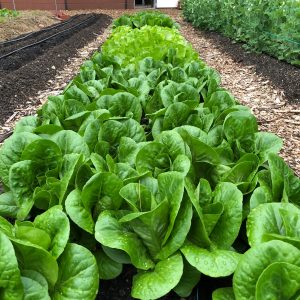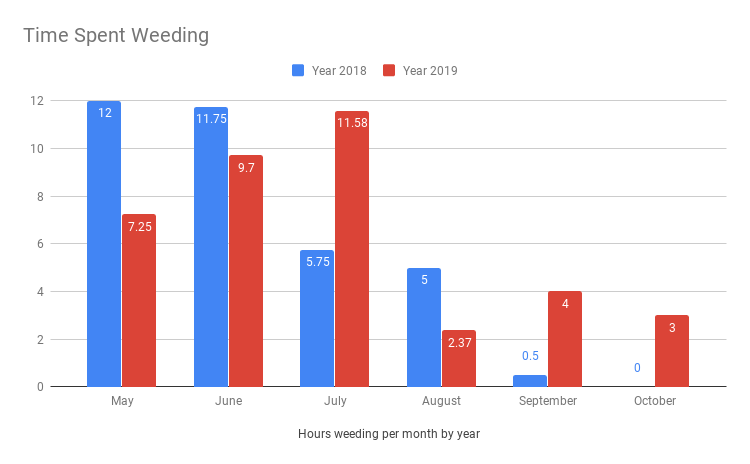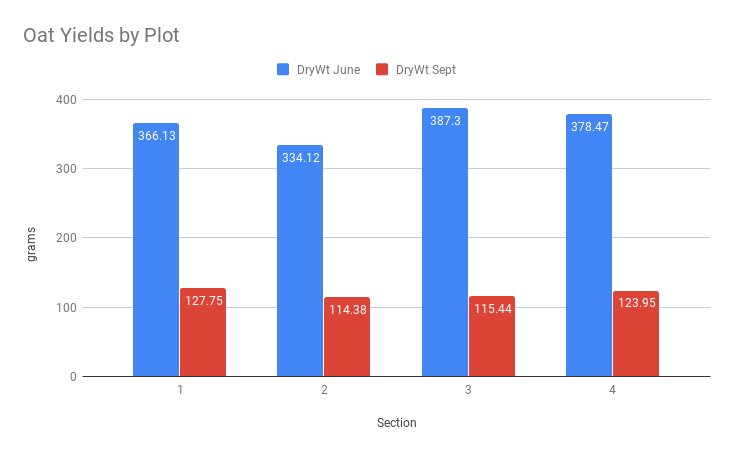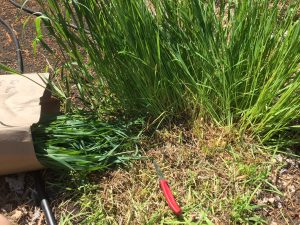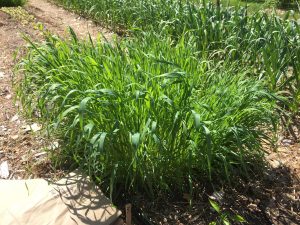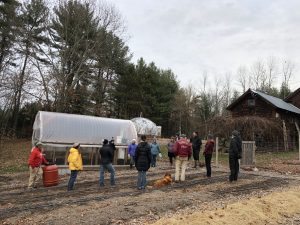Final report for FNE18-914
Project Information
Through this on-farm research study, we sought to determine how one acre of no-till permanent raised bed (PRB) fruit and vegetable production system affects weed suppression, soil health, and production potential across four plots. The first plot was established in 2014, with one new plot established each year over the next three years (2014-2017), allowing us to explore how the system changed over time. We assessed the system’s effectiveness suppressing weeds by evaluating the weed seed bank through a greenhouse study, measuring weed presence and abundance through a bi-weekly weed survey, as well as tracking all hours spent weeding. We tested soil health by collecting soil samples and sending them to the Cornell University Soil Health Lab. To assess production potential across all four plots, we sowed oat grass, harvested, dried, and weighed the biomass. We found that all four plots have high weed diversity, but low abundance, and across one acre in all four plots, the average time spent weeding increased slightly from 2018 to 2019 (35 to 38 hours between May and October), which we attribute to weed seeds being introduced from above ground, both from outside the system, as well as from inside the system (i.e., seeds from previous crop plantings). Put another way, we spent an average of 3% of our time weeding, or an average of $547.50/farm labor/season. Soil health tests indicated optimal soil health in all four plots, with overall scores between 86-97. Biological soil health indicators from the PRB system improved between 2018-2019, and had higher (better) scores compared to control samples (avg 98.75 in 2019). There was no significant difference in yield (p=0.987) as measured in dry weight of oat grass. Overall our results indicate that this PRB system is effective at weed management, building soil health, and producing consistent yields. In November 2019, we hosted an on farm tour and discussion as part of the UNH Cooperative Extension twilight meeting series, with 15 farmers in attendance. We presented at both the 2018 and 2019 NOFA New Hampshire annual winter conferences, with around 30 participants at each presentation, including farmers, gardeners, and technical assistance providers.
Our farm is located on a glacial Esker, with a thin organic horizon on top of 1.5-2 meters of sand. To address the lack of organic matter on the farm, we decided to establish a no-till Permanent raised beds (PRB) system to build soil and soil water holding capacity. Anecdotally, the no-till PRB system we established on my farm has allowed us to effectively build soil organic matter, manage weeds, and increase overall yields compared to the more traditional organic agriculture practices our colleagues have been using. However, we have not formally collected the data necessary to validate these observations.
Our research has three main objectives that will provide quantitative data to help improve on-farm productivity, reduce production and management costs, and improve farm viability, while building healthy soils. To better understand how our PRB system works, we will (1) assess effectiveness of weed suppression, (2) evaluate soil health, and (3) calculate production potential for three main crops, strawberries, garlic, and mixed leafy greens. We will conduct the proposed study for two growing seasons in 2018-19.
Permanent raised beds (PRB) are used for various cropping systems throughout the world, but are still not common for commercial, small scale, mixed vegetable production in the Northeastern United States. A PRB system intentionally designates permanent growing space for crops that is cultivated year after year, and often includes tilling the rows while leaving the inter-rows untouched. Forming beds with a tiller or other shaping equipment to mound soil in the rows, makes the beds slightly higher than the walkways or inter-rows. In an ideal system, PRB increase soil water holding capacity, soil organic matter (SOM) formation, and soil temperatures; and reduce soil erosion and nutrient leaching compared to conventional production systems (Govaerts et al., 2007; Gathala et al., 2015). However, there is no scientific, peer-reviewed research available on no-till PRB systems specific to New England agriculture, though it may be a valuable practice for improving soil health, reducing weed pressure, and increasing production capacity.
Many weeds have evolved resistance to herbicides in conventional systems, causing ongoing management concerns (Heap, 2017). Organic production often relies on tilling or plasticulture to control weeds (Kasirajan and Ngouajio, 2012). However, tilling can compromise soil health and disturb the weed seed bank; and plasticulture is costly, requires specialized equipment, and creates disposable waste products. All three weed management methods create annual expenses and require hours of on farm labor. It is not uncommon for direct sown crops (e.g., carrots, leafy greens, beets, etc.) to be outcompeted by weeds, and thus lost income for the farmer. Scientific research on weed management within PRB systems is lacking.
Also, while the number of farmers in New England has risen over the past decade, the number of prime farmland acres in production has decreased (USDA, 2012). As the interest in agriculture increases, but the availability and accessibility of prime farmland decreases, we must explore the possibilities for bringing marginal lands into production, without compromising yields and thus farm viability. As PRB systems have been found to increase SOM formation, these systems could be one means of converting marginal lands into productive agricultural systems.
Additionally, traditional agricultural plantings often spatially constrained to fit farm equipment (e.g., the width and distance between beds is determined by the tractor and attachments for tilling and planting). No-till PRB systems are not limited in configuration, as fossil-fuel powered equipment is not necessary, therefore, farmers can plant more intensively. Given that biologically intensive agriculture has been shown to increase yields compared to traditional organic agriculture (Algert et al., 2014), it is possible that production capacity in no-till PRB systems could be higher than traditional agriculture. In general, previous research, and my own farming experience suggests that no-till PRB system have a “lower barrier to entry”; with decreased long-term capital inputs (e.g., the need for expensive equipment and labor for weed management).
Jennifer Wilhelm has been working in small fruit and vegetable production for over ten years, and managing a small-scale mixed fruit and vegetable commercial operation for four years. We bought our farm in 2013 and began building a no-till permanent raised bed system in 2014 on one acre. Jennifer works part-time managing the fruit and vegetable production, with one-two part time employees. Her husband works part-time managing the maple sugaring operation. Garlic and maple syrup are the two highest yielding and grossing farm products.
Cooperators
- - Technical Advisor
Research
As my permanent raised bed (PRB) systems were established over the course of four years, I effectively have a time series of PRB systems at different levels of “maturity." This time series will allow me to determine how PRB systems change over time and determine if there are differences in weed suppression, soil health, and/or production capacity as the PRB system matures. To build each PRB system, I covered the existing sod with 10 cm of hardwood chips, and constructed each PRB to be 81 cm wide, with varying lengths, using compost, and 46 cm between rows. Crops are rotated between beds within each PRB system several times per season, with a cover crop seeded at the end of the growing season in early fall. Black silage tarp is used for three weeks prior to planting all crops to germinate and kill any surficial weed seeds and warm the soil. Garlic is an exception to this as it is planted in the fall and mulched with 10 cm of chopped maple leaves/saltmarsh hay. We do not till, and do not use any fossil fuel powered equipment in the systems; all farm tasks are done by hand.
Weed Management Plan
I will work with Dr. Richard Smith’s agroecology lab to address each of my objectives. To assess how effective my farm’s PRB system is at suppressing weeds, each week I will pull and collect all weeds found within the four systems. The weed biomass will be bagged, labeled and picked up by a Smith lab technician, who will identify, sort, dry, and weigh all weeds at their lab at UNH. I will also track the number of hours spent weeding each week. This will allow me to quantify the amount of weeds growing in the production areas, and how much farmer time is devoted to weed management. Additionally, an undergraduate lab technician will conduct a weed seed bank analysis at the UNH greenhouses to identify and quantify the density and species composition of the soil weed seed bank. To do this, we will collect soil cores from the rows and inter-rows, from each of the systems at the beginning of the growing season. Three randomly selected soil cores will be taken to a depth of 10 cm from each row/inter-row, mixed, and a 50 g subsample of the mixed sample will be used for analysis. Thus, each composite sample will be representative of a row/inter-row within its respective system. We will then spread the soil sample on a soilless medium in plastic trays, and place the trays in the UNH greenhouse where they will be kept moist. Each week, a lab technician will identify, count, and remove any weeds that have germinated from the trays. This will allow me to understand the potential weed community that is suppressed by the PRB system and whether this community shifts as PRB systems mature.
Soil Health Plan
To determine if soil health differs across the time series, we will collect soil samples from the rows and inter-rows within each treatment, as well as from the surrounding sod. To sample, three randomly selected cores will be taken from each row/inter-row, mixed, and a subsample of the mixed sample will be used for analysis. Thus, each composite sample will be representative of a row/inter-row within its respective treatment. The samples will be packed in a cooler and shipped to the Cornell Soil Lab for a Comprehensive Assessment of Soil Health. These data will be used to understand how my PRB system affects soil health over time and if soils in PRB differ from the unmanaged sod.
Yield Measurement Plan
To determine production capacity, I will measure yields for three main crops on the farm, strawberries, garlic, and mixed leafy greens. Crops will be weighed using a certified Tor Rey L-EQ series scale. Only marketable yields will be measured each week, as marketable crops are what contribute directly to net farm income. Garlic scapes will be weighed separate from garlic bulbs, as each are distinct salable crops. Leafy greens will be weighed as one category of crop, but will include up to five different vegetables (e.g., spinach, head lettuce, lettuce mix, kale, and swiss chard). Yields for each crop will be averaged per square meter of bed space and compared to yield averages of traditional organic production.
Timeline of Activities Planned
Each growing season (2018 & 2019), I will begin collecting weeds the first week in April and conclude October 31. I will track farmer weeding hours daily. Soil cores for the weed seed germination study will be collected in April 2018, and the UNH analysis will commence the same week. (These data will only be collected in 2018). Soil cores for the Cornell Soil Health Test will be collected and mailed at the end of each growing season. Strawberries will be weighed throughout the growing season (anticipated July-early November). Garlic scapes will be weighed at harvest, sometime in mid-June. Garlic bulbs will be weighed after harvest for garlic sold fresh, and after curing for garlic sold for storage/seed, in mid-July through October. Leafy greens will be weighed at harvest, between May and October. In early November 2019, all the data will be compiled and analyzed.
Weed Management (2018 - 2019)
We worked with Dr. Richard Smith’s agroecology lab to address each of the objectives. To assess how effective the farm’s PRB system is at suppressing weeds, we proposed to conduct a weed seed bank study in the greenhouse; pull and collect all weeds found within the four systems each week, bag, label, and dry the biomass for total weight;and track labor hours spent weeding.
An undergraduate lab technician from Dr. Smith’s lab conducted a weed seed bank analysis at the UNH greenhouses to identify and quantify the density and species composition of the soil weed seed bank. To do this, in May 2018 we collected soil cores from the rows and inter-rows, from each of the four plots. Three randomly selected soil cores were taken to a depth of 10 cm from each row/inter-row, mixed, and a 50 g subsample of the mixed sample were used for analysis. Thus, each composite sample was representative of a row/inter-row within its respective plot. We then spread the soil sample on a soilless medium in plastic trays, and placed the trays in the UNH greenhouse where they were be kept moist through September 7, 2018. Weeds were identified at first true leaf from June 5 through June 7, 2018.
This study indicated that there are at least 34 different weed species present in the weed seed bank. Some species were more abundant in one or more plots, while other species were found in all four plots. For example, Portulaca olerea (purslane) was found to be the most abundant weed in plot 1 (n=364), but was barely present in the other three plots (n=30). On the other hand, Juncus tenuis (slender rush) was present in all four plots. This study gave us a picture of the weed species and relative abundance we might expect to see in the field.
We began pulling and collecting weeds in the spring of 2018, however we realized early in the first year that this process was burdensome; it took longer to do than weeding with a hoe, the method we traditionally use to weed, which was skewing the data we were collecting on time spent weeding. To address our objective, we therefore included regular visual survey of all weeds in bed rows (row) and interrow (aisles), where we identified weed species and listed (richness), then ranked species by consensus, with the top 1-5 species ordered. This allowed us to understand both the diversity and abundance of weeds.
The visual weed surveys of diversity and abundance in each plot showed a greater diversity of weed species (2018 n=71, 2019 n=85) than the weed seed bank study. This suggests that there may be more weed seeds entering the system from aboveground than were present in the soil belowground. We also saw an increase in the diversity of weed species from 2018 to 2019. This increase was due in part to “volunteers” from previous crops. For example, we saw snapdragon, Swiss chard, husk cherry, carrot, strawberry, tomato, and sweet annie; all crops that we had previously planted. In 2018, weed diversity and abundance was often higher in the interrows (walkways) than in the rows (growing spaces), which is likely due to a thinner layer of organic matter (10 cm of wood chips) smothering the sod and weed seed bank below compared to the rows (10 cm of wood chips and at least 10 cm of compost). The time series did not seem to influence the diversity or abundance of weeds.
We tracked the number of hours spent weeding each week, which allowed us to quantify how much time was devoted to this one task. We weeded regularly, attempting to pull all weeds before they went to seed. In 2018, we spent a total of 35 hours weeding, while in 2019 we spent a total of 38 hours weeding. The increased time spent weeding suggests that the weeds not only increased in diversity but also abundance. We did not track hours weeding by plot, though according to our weed survey, which indicated abundance changed in each plot from month to month, weeding hours by plot were likely similar over time.
Soil Health (2018 - 2019)
We anticipated that there might be a difference in production potential across the plots, relative to when the plots were established (i.e., older plots performing better than new plots), as we had observed that crops did not perform well in the first year after bed establishment. We attribute this to the woodchips robbing nitrogen from the soil to breakdown. Due to this observation, we stopped planting cash crops the same season the beds were established, instead sowing a cover crop and allowing time for the soil ecosystem to develop.
To determine if soil health differs across plots, we collected soil samples on October 31, 2018 and November 25, 2019 from the rows and inter-rows within each plot, as well as from the surrounding sod. We took approximately 15 cores, 1" cores to 10 cm ~3 cups in plots 1, 2, 3, 4 row, as well as interrows in each plot. In 2018, we included two extra samples from the surrounding sod. To sample, three randomly selected cores were taken from each row/inter-row, mixed, and a subsample of the mixed sample was used for analysis. Thus, each composite sample is representative of a row/inter-row within its respective plot. The samples were packed in boxes and shipped to the Cornell Soil Lab for a Comprehensive Assessment of Soil Health. These data were used to understand how our PRB system affects soil health over time and if soils in PRB differ from the unmanaged sod. The health tests that we had measured included indicators of soil physical (aggregate stability), biological (organic matter, soil respiration, and active carbon), as well as chemical (soil pH, extractable phosphorus, extractable Potassium, and minor elements) health.
2018 and 2019 soil samples indicated overall quality scores between 86 to 97, “Optimal” soil conditions for all four plots. Three of the plots tested high in phosphorus in 2018 and all four tested high in 2019, indicating the potential for runoff and a need to reduce phosphorus inputs. Given the lack of soil organic matter prior to establishing our PRB system, it is notable that plots had scores of 99 to 100. Soils with high organic matter improve soil water holding capacity and nutrient retention. Additionally, in plots 2 and 3 soil respiration, an indicator of biological activity, increased from 2018 to 2019 (85 to 99 and 87 to 99 respectively). Plots 1 and 4 had high soil respiration scores both years (98 to 99). In 2018, we tested soil samples from the sod surrounding the production areas as a control. Overall scores for the control samples tested within the optimal conditions range. However, results showed lower scores for soil respiration (low = 63) and active carbon (low = 48), indicating lower microbial activity and lower biological soil health compared to the production areas.
Yield Measurements (2018 - 2019)
To determine production capacity, we had proposed to weigh yields of three different crops, strawberries, greens, and garlic. However, due to crop rotation plans, we did not have overlap of crops between the four plots. In other words, we did not have replications of each crop within each plot, therefore, comparing yields would not tell us much about if/how yields differ by plot. Therefore, in year two, we planned to standardize crop production by growing oats in each plot. We seeded two quadrats of oats in each plot on May 13, 2019 for a summer harvest and August 12, 2019 for a fall harvest. Oats were harvested by cutting at soil level using a harvesting knife on June 25, 2019 and September 18, 2019. Biomass was bagged, labeled, dried in ovens at UNH Kingman Farm facility, and weighed. We found that yields (dry weight of oat biomass) did not differ significantly by plots (p=0.941).
Through this on-farm research study, we aimed to assess how our no-till permanent raised bed fruit and vegetable production system affects weed suppression, soil health, and production potential across four plots. The four plots were established between 2014 and 2017, allowing us to explore how the system might change over time. We assessed the system’s effectiveness suppressing weeds by evaluating the weed seed bank through a greenhouse study, measuring weed presence and abundance through a weed survey, as well as tracking hours spent weeding. We tested soil health by collecting soil samples and sending them to the Cornell University Soil Health Lab. To assess production potential across all four plots, we sowed oat grass, harvested, dried, and weighed the biomass.
The data indicate that our farm has high weed diversity, but low abundance. While there were differences in weed species between plots, there did not seem to be a difference in relative abundance. Across one acre in all four plots, the average time spent weeding increased slightly from 2018 to 2019 (35 to 38 hours between May and October), which we attribute to weed seeds being introduced from aboveground, both from outside the system, as well as from inside the system (i.e., seeds from previous crop plantings). Put another way, we spent an average of 3% of our time weeding, or an average of $547.50/farm labor/season. We know that labor is a major cost of production; less time spent dedicated to this task, the more time farmers would have to dedicate to other pressing farm tasks. We see this as the most important result of our research, indicating that the establishment and management of this no-till permanent raised bed system is unusually effective for weed management. Further research quantifying time spent weeding in other fruit and vegetable production systems, particularly in traditional organic production systems would put our data into context. Soil health data show that overall the physical, biological, and chemical indicators in each of the four plots are in optimal condition. In both years, organic matter had a score that ranged between 99-100 (100 being the highest score). Such high organic matter suggests that the Permanent Raised Bed system is efficient at building soil, which helps to prevent run-off, increases water holding capacity, and creates an ideal environment for the soil microbial community and crops to thrive. In both 2018 and 2019, phosphorus was high in all four plots, indicating a need for a shift in fertilizer management. All other soil health indicators were in the optimal range. We did not see any significant difference in yields between plots. This is a welcome finding as it demonstrates that one year after the plots are established, with proper management, they produce consistent yields.
Education & Outreach Activities and Participation Summary
Participation Summary:
I presented about our research project and shared preliminary data from year one at the NOFA NH annual winter conference on March 16, 2019. There were about 30 participants including farmers and home gardeners. I created and shared a PowerPoint presentation about our experience with no-till permanent raided beds.
I also hosted an on farm twilight meeting and tour on November 14, 2019. We had about 15 people attend the twilight meeting. Each participant received a fact sheet about our experience with no-till permanent raised beds.
I presented at the NOFA NH 2020 winter conference on February 8, 2020. There were around 30 participants including farmers, home gardeners, and technical assistance providers.
I will also work on a publication through UNHCE, and will consider the possibility of a peer review article after all data has been analyzed.
Learning Outcomes
Farmers were most interested in the concept of smothering the weed seed bank as an effective strategy for overall weed management; reducing labor hours on weeding. This seemed especially appealing in terms of potential long-term financial savings on labor costs.
Project Outcomes
This study provided data that supports previous observations; our no-till permanent raised bed system is a very effective weed management strategy. By managing weeds passively (i.e., smothering the weed seed bank and not disturbing it by tilling), we save tens of hours and thousands of dollars of farm labor. Additionally, we gain this benefit while maintaining consistent yields. We now feel confident encouraging other farmers to consider transitioning production space to no-till permanent raised bed systems.
We did have to make changes to our proposed methodology based on conditions in the field. For example, we had proposed to pull and weigh all weeds, which turned out to be more time intensive than our typical method of weeding with long-handled tools. We therefore switched gears to include a bi-weekly weed survey, noting weed species and relative abundance of each species. Similarly, we had to shift our methodology for assessing yield, as our crop rotation did not allow us to compare the same crops across all four plots. Due to this oversight, we were unable to compare yields in 2018 (year one of the study), but developed a new plan for 2019; sowing quadrats of oat grass in each plot.
The data show that our no-till permanent raised bed system reduced weed pressure, improved soil health, and had consistent crop yields across plots. Given the lack of weed pressure, we did not lose any crops to competition with weeds. Additionally, we do not have to rely on heavy tilling or plastic mulch for weed control, reducing labor and materials/equipment costs. We also recommend further research quantifying time spent weeding in other fruit and vegetable production systems, particularly in traditional organic production systems would put our data into context.The soil health tests indicate that while we need to improve our organic fertilizer management strategy to reduce high levels of phosphorus across all four plots, all other soil health indicators point to optimal growing conditions. We also know that our crop rotation is not limited, as we can count on having consistent yields across the one acre of production areas.
If farmers are interested in establishing a similar system, we recommend that they do so by transitioning sections of their production area over time to avoid potential issues with reduced yields immediately following establishment. If farmers rotate crops and have fallow fields, one method could be to transition the fallow areas each year, until the desired acreage has been established into permanent raised beds.
Information Products
- Managing weeds passively with no-till permanent raised beds (Conference/Presentation Material)
- Twilight Meeting: Permanent Raised Beds (Fact Sheet, Manual/Guide)
- Building a Regenerative Agricultural System using No-Till Permanent Raised Beds (Conference/Presentation Material)
